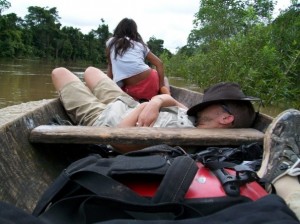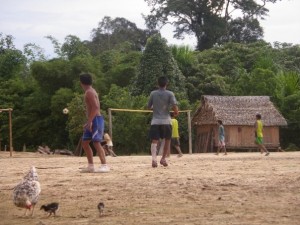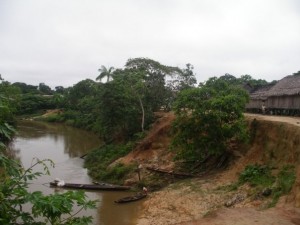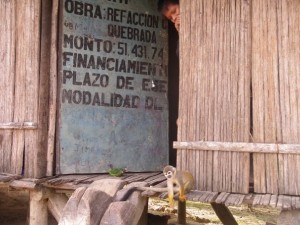Published!
It’s out! After ten years of publishing only at conferences (which is more standard in computer science) I have an actual journal article:
Robert Munro, Rainer Ludwig, Uli Sauerland and David Fleck. 2012. Reported Speech in Matses: perspective persistence and evidential narratives. International Journal of American Linguistics. 78:1, 41-75. (http://www.jstor.org/pss/10.1086/662637)
I wrote a previous blog entry about one day of fieldwork so I’m going to devote this one to the combination of linguistic theory and travel that got me there. How exactly did I end up spending eight days traveling to study just one aspect of such a remote language?Noam Chomsky.
Of course.
Along with two other language researchers he published an article in Science that suggested that every human language (and no non-human language) contained recursion. It is an issue that goes right to the heart of human existence – what mental capacities separate us from other animals (if any) and how is this manifested in language, the most complex interaction of cognitive and social action?
For Chomsky, the primary distinguishing feature is recursion. Recursion, put simply, means any process or structure that self-embeds. The idea that human languages have recursion is easy to demonstrate. In fact, I just did. The last sentence had another one embedded in it. That is, “human languages have recursion” was embedded within “the idea is easy to demonstrate” (I know, very meta). The theory can be disproved in two ways: finding an animal-language with recursion or finding a human language without recursion.
Proving that only humans have recursion in their language has to led to a lot of monkey-time, with people coercing poor apes in to admitting “the idea that bananas are very tasty is correct” (or something along those lines). There have also been some very heated debates with a counterargument in Nature that claimed that the European Starling has a recursive song. Yes, grown men and women have argued about the recursive nature of bird-songs.Proving that all human languages have recursion means studying every possible outlier. Not every language embeds sentences like those above and would be limited to sequential ordering. For example: “humans languages have recursion; this idea is easy to demonstrate”. You could say (arguably) that this chain is purely sequential and not recursively embedded. However, it was thought that you could always embed other people’s utterances within your own. For example, you could say, in any language, something like “Rob said that bananas are tasty yesterday”. It is often on the existence of this type of ‘reported speech’ that the recursion claim is tested.
Far from the European Starling, the Matses have been living in the Peruvian and Brazilian Amazon for … well, no one really knows how long. They were living their traditional lives until the 1960s. As they mainly kept to non-navigable headwater regions deep in the forest, they were largely left alone, but throughout the 1900s they had increasingly been fighting the governments of each country. In the late 60s and early 70s they took amnesty, with most of the Matses population taking refuge at two missions, one each in Peru and Brazil. The rest of the Matses are still ‘uncontacted’ although it’s not a very accurate word as they regularly bump into the ‘contacted’ people of the region as each go about hunting trips (the well-known National Geographic photos might be Matses as it is the same valley). In the 1980s the Matses left the missions and resettled along rivers in the region. Their language was studied for the first time during this period.
Cue David Fleck (one of my coauthors). He moved to the region and in 2003 he wrote a paper that mentioned, in passing, that Matses only had direct speech. Direct speech is simply when you quote someone (near) verbatim. Imagine that yesterday I told you: “I will go there tomorrow”. You could then quote me directly:
- Rob said “I will go there tomorrow”
In English (and people have theorized, every language) you can also use ‘indirect speech’, and rephrase what I said from your own point of view:
- Rob said he is coming here today.
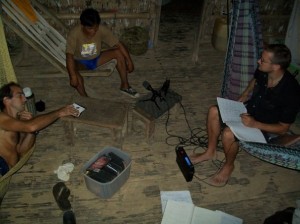
Working with David (left) and Abraham (center) in our 'office'. Note my collared shirt - I don't care where we are, people, this is still a work day!
- Rob said that he would be rocking up around now
You can say this without people thinking that I really say silly expressions like “rock up”, but you could not rephrase it in the case of direct speech. For indirect speech, too, you can also ‘extract’ some of the embedded sentence in ways that are not possible for direct speech. This is most obvious in questions:
- Where did Rob say he was going tomorrow?
In linguistics, we usually treat the ‘where’ as being extracted from the embedded sentence. This is not possible with direct speech:
- Where did Rob say “I am going tomorrow?”
This doesn’t sound like it is from Rob’s point of view. It actually makes it sound like indirect speech that is talking about where you are going. In other contexts/configurations, it would sound completely ungrammatical. There are a few other well-documented differences, too, but they are more technical/linguistic, so I won’t going into them here.
Matses is one of the languages that does not generally allow one sentence to be embedded within another, so the test for whether it did not contain recursion relied on whether it really did only possess direct speech.
As a quick aside, it needs to be pointed out that the lack of sentence embedding has nothing to do with overall complexity. For example, Matses has an obligatory evidential system that marks each sentence for how the speaker came to know about an event. In English, we obligatorily mark verbs for tense: “I kick-ed”, “I am kick-ing”, “I will kick”. Not all languages require this, like Chinese, where you encode the time separate from the verb. In English, we code evidentiality separately. For example, you might say “I saw him kick the ball”, “I inferred from seeing the ball move that he kicked it”, “I guess he kicked the ball”, “someone told me he kicked the ball”. In Matses, these form part of the verb suffix. There is an obligatory suffix that expresses that the speaker either knows something from direct observation, by inference, or that it is conjecture (if you know because someone told you, you have to quote them). Put simply, you can’t create a grammatical sentence in Matses without first considering how you came to know about the information you are sharing. It’s actually a little more complicated than just that, as there are different suffixes for different evidential/tense combinations, and more complicated than English in this, as there are also different past tenses for recent past, distant past and remote past events. To borrow the suffix into English, you might say something like “he kick-ond the ball” (I saw him kick the ball some time ago) or “he kick-ak the ball” (I infer that he recently kicked the ball). If fact, it is even more complicated than that, too, but it took 10 pages to explain in the paper so I’m going to leave it out here. It is a unique and beautiful language, just one that doesn’t allow productive embedding.Back to recursion and how it took me to the Amazon.
A researcher in Europe looks up from his paper (a fascinating treatise on bird-song structure) to see an email from David Fleck, inviting him to study the Matses. The researcher couldn’t make it, but it bounced through other people and the invitation found its way to Uli Sauerland. Uli was a visiting scholar at Stanford at the time and while he could not himself make it, due to other fieldwork commitments, his student back in Germany, Rainer Ludwig, was keen to go (the four of us rounding out the authors on the final paper).

Rainer (left) with Daniel, who was our most active language consultant and helped us run many of the experiments.
After stashing my bicycle in Lima (I followed my fieldwork by cycling across the Andes) I met Rainer in Iquitos, clutching a print-out of David’s instructions. David’s email was all in capital letters and was a long list of instructions for how to get to Estiron, the village he was based in: negotiating passage on a cargo plane from Iquitos, the nearest city, to Angamos, the nearest village where a small craft could land; finding someone with a dugout canoe; obtaining enough fuel for an attached motor; and how to first contact him via short-wave radio when close. (I keep meaning to ask David why the email was all-caps – he’s out of contact again right now). I kept the print out close for the week it took us to get there. ALmost everything had changed in the time since he sent it, but we were able to piece everything together.
Iquitos is the world’s largest city that cannot be reached by land. Sitting where two rivers join to form the Amazon, the only way in or out is by plane or boat. Some 4000kms from the ocean, the river is still almost too wide to see across. We spent several days here negotiating our way onto a boat-plane (including two days just sitting beside it waiting for the weather to clear). Short-wave radio contact with the village was complicated. The Matses only turned on the radio for an hour a day and because of the storms (I think) there was a lot of static. I can’t remember if it was in Iquitos or when we tried again in Angamos, but after several attempts and a lot of slow-talk-shouting that only received static in reply, we heard one sentence come through clearly “we are expecting you”. It had been more than a year since David had first sent the email, so with this small warning of our arrival and invitation we were on our way.Angamos was more developed than I anticipated – it had a long paved walking path along a line of well-built houses. It was a border town, although I never saw the sister village which was down river a little way on the Brazilian side. After a few more days of collecting enough fuel from different villages, and a guide/boatman in Alleandro, we set off in our dugout for the 10 hours to Estiron. It was the rainy season and the rivers were flooded, so we kept near the shore to avoid the stronger currents. One small hole in the bow lapped water into the boat and we sat low, but it was sturdy enough. I was comfortable enough to nap, safe in the knowledge that Rainer was keeping everything afloat through sheer willpower.
Eight days from when I left San Francisco, and six from when I arrived in the Amazon, we finally rocked up in Estiron, our main fieldsite. The village is nestled beside two bends of the Chobayacu Creek, with two rows of thatch huts near the water and several more scattered back into the forest. The area is surrounded by farms, but they are not visible from the water or village, and sometimes not even when you are in them – they are partially-cleared pockets of forest planted with a scattering of fruit and yams. Between the farms, fish, and a regular supply of bush-meat, no-one had to work very hard to stay healthy. A few found-objects aside, the huts were made according to traditional practices – wood and thatch from the forest. Most of the huts were large airy buildings low to the ground (we set up home and office in one) but a handful of smaller ones were on longer stilts several meters in the air. It was explained to us that this was a recent fashion for some of the younger Matses (I recently built a raised platform in my own sunroom – I think I get it). The football field and volleyball net were also more recent additions.So did we discover whether or not Matses contained recursion? I think we did find an answer, but our paper leaves it to the reader, simply laying out our observations, examples and experimental methods. You are welcome to read it and decide for yourself!
Rob
December 20, 2011
Acknowledgments: Thanks to the Characterizing Human Language by Structural Complexity (CHLaSC) Project, who funded much of the research, and Amy Rose Deal of Harvard for citing us (already!)
